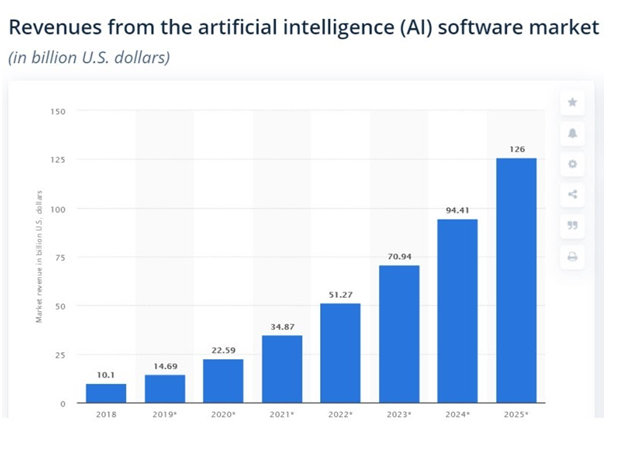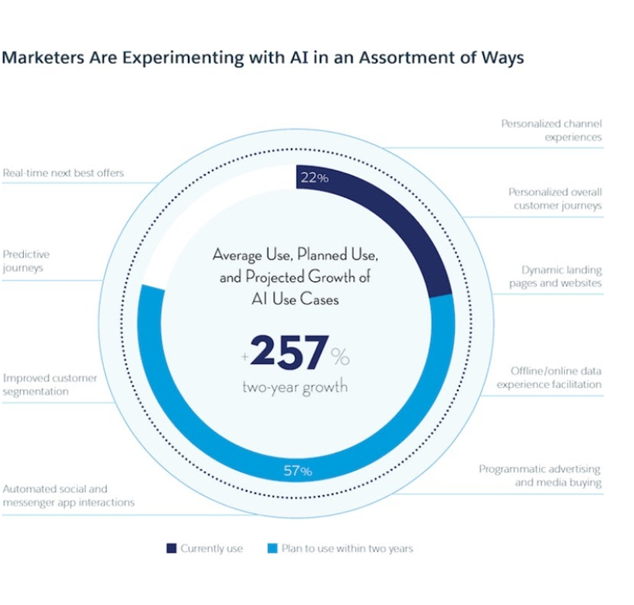The Difference Between AI Machine Learning and Deep Learning – And Why They Matter
Technology is developing today at a pace that’s never been seen before. New advancements and breakthroughs happen far more readily than at any time in the past. One of the most talked-about areas of cutting-edge tech is that of artificial intelligence (AI).
AI is driving the digital transformation of organizations in all manner of niches. So wide-ranging are the applications of AI, that you’ve probably already interacted with an example of the tech today. Despite AI’s growing ubiquity, though, it’s still not an area that’s readily understood.

One of the main reasons that it’s tricky to get your head around AI is that the field has its own lexicon of phrases. Video conferencing software may get described as AI-driven or using machine or deep learning. That could tempt you to choose the solution. But, do you truly understand what it all means?
If the answer’s no, you’ll want to read on. You’ll also be by no means alone in giving that response. The terminology of AI is far from straightforward. Get to grips with AI, machine learning, and deep learning, though, and you’re well on your way.
AI – What Does it Mean?
When many people hear about AI, their first thoughts may still be for science fiction films of years gone by. There was even a blockbuster named, simply, ‘AI’. The truth is, though, that artificial intelligence has been a part of real-life for years now.
As a phrase, AI refers to any technology which works to mimic human intelligence. Some of the hallmarks of human intelligence that AI aims to replicate include:
- Cognition
- Learning
- Problem-solving
- Pattern recognition
- Reasoning
A common misconception is that a solution or piece of software can either be or use AI. Such tools are better described as displaying or exhibiting AI. They’re artificial – they’re machines, after all – and are displaying intelligence.
Aside from migration to the Cloud, adoption of processes that exhibit AI is probably the most widespread tech trend of recent years. Everything from a web meeting platform to an analytics suite may adopt some elements of AI.
Recommended: Great SaaS Companies Need Great SaaS Ecosystems: 5 Ways To Build A Defensible Business In The Cloud
Two of the most widespread AI processes are machine learning and deep learning. These are often the innovations that so-called AI-driven solutions leverage. That begs the obvious question, then, of what is machine learning?
What is Machine Learning?
As mentioned, the first thing to understand about machine learning is that it is an example of AI. It’s one particular process by which an artificial system can display intelligence. Put simply – and as the name suggests – it’s when a machine can learn.
By ‘machine’ in this context, we mean an algorithm. By ‘learning’, we mean taking – ideally – a large volume of data and using it for specific pre-defined tasks. Typically, machine learning algorithms analyze sets of data and identify patterns. They then use those patterns to generate conclusions or take defined actions.

Machine learning algorithms get smarter as they go along. The more data the algorithms analyze, the better their predictions, conclusions, or actions. A straightforward example is an algorithm used by video or music streaming services.
Those algorithms collect data on the choices that users make. That means things like which artists people listen to or the genre of programs they watch. They then use the data to predict and recommend new bands or shows that users may like. The more data the algorithms process, the better they can forecast what a user will enjoy.
The applications of machine learning go far beyond streaming and entertainment. But we’ll talk about that later. First, we need to discuss deep learning and how it’s different.
How’s Deep Learning Different?
We must begin our definition of deep learning in a similar way to that of machine learning. In this case, it’s vital to understand that deep learning is machine learning AND an example of AI. In many ways, it’s the next evolution of machine learning.

Machine learning algorithms deal with structured and labeled data.
They analyze it, create more data, and use that to generate conclusions or predictions. When outcomes aren’t as desired, the algorithms can get ‘retrained’. That’s via human intervention. As compared to the human brain, machine learning algorithms are simplistic.
Deep learning is the process that’s attempting to close the gap between artificial and human intelligence further.
Rather than a hard-coded algorithm, deep learning utilizes many-layered and interconnected examples. That’s to replicate better our brains, which combine tens of thousands of neurons.
Systems of deep learning algorithms are known as artificial neural networks. They’re literal – if still more straightforward – copies of the human brain. Being built as they are, allows deep learning networks to do far more than machine learning algorithms.
Such networks don’t need structured data to operate. They’re able to make sense of unstructured and unlabeled data sets. What’s more, with enough ‘training’ they can make sense of far more complex information. And can do so at the first time of asking.
![Deep Learning Model [Image Source: researchgate.net]](https://aithority.com/wp-content/uploads/2020/07/s4.png)
One of the areas to which deep learning is crucial is that of self-driving cars. It’s the ability of artificial neural networks to assess and process complex information that makes such things possible. They help cars to ‘understand’ the environment around them.
Autonomous vehicles can recognize road signs, pedestrians, other road users, and more. They can also spot patterns in how those things are behaving. Doing so is crucial in the case of pedestrians and other vehicles. It allows the cars to react accordingly and is all down to deep learning.
Why do I Need to Know All That?
Fascinating as AI and its elements undoubtedly are, why should you care? It’s a fair question with a definitive answer. You must care about AI, machine, and deep learning because it’s impacting marketing in a big way.
The MarTech solutions of the future – and the present – will almost all exhibit elements of AI.
If you’re in the SaaS niche or involved in other marketing, you’ll soon come across AI-enabled solutions. That’s assuming you haven’t already.
Applications of Machine Learning
Machine learning is already getting leveraged in a broad array of MarTech solutions. From webinar services to chatbots, the element of AI is making all kinds of software or tools smarter.
We’ve already talked about how machine learning gets utilized for recommendations. That extends to products, as well as artists or TV shows. It’s the basis of the kind of ‘you might also like’ sections that you often see on e-commerce websites.
That’s far from the only marketing application of machine learning. With a machine learning algorithm, you can make better sense of your customer data. And do so in a fraction of the time.
Say, for instance, that you want to run a targeted campaign. One focused on a specific sector of your target audience. Machine learning allows you to segment the audience with greater accuracy.
An algorithm can use the data from your current CRM or other sources to produce sample personas. It can then ID those leads in your email list or database who match the characteristics of the personas. This can be like a silver bullet for customer acquisition.

Chatbots, too, can use machine learning to aid an organization’s marketing. Many companies now implement a chatbot on their website. They’re those little chat windows which pop up to see if you need help when you load a webpage.
Thanks to machine learning, visitors to a site can hold a full – and useful – conversation with the chatbot. The algorithms behind the tool get trained to recognize queries. And to provide the right responses. From a marketing point of view, that may mean pointing a site visitor to the correct product or service.
Applications of Deep Learning
Chatbots and other channels of written communication are also hotbeds for deep learning in MarTech. That’s thanks to the possibilities afforded by natural language processing (NLP). NLP is a further aspect of AI and is made possible by the artificial neural networks of deep learning.
Human language is incredibly complex. Just think back to the maddening grammar rules and exceptions of high school English. For computers or machines, the nuances of language have long been impossible to decipher. That, though, is no longer the case.
Via deep learning and NLP, algorithms can now grasp meaning and context in language. That has profound implications for marketing as well as customer service, where the tech is more often applied. Take, for instance, the two vital aspects of marketing that are SEO and content creation.
Keyword research is a crucial element of SEO. It’s about recognizing the words and phrases for which your target audience search. NLP can supercharge this process. You can use algorithms to generate more accurate keywords—all through using existing written communications from your customers.
In content marketing, it’s vital that all content is useful and interesting to its audience. NLP can help in this regard, too. With NLP, you can better recognize what’s important to your customers. You might, for instance, use an algorithm to ID common topics on a company forum. That shows you your customers’ interests and shows useful topic ideas for content.
That’s purely the tip of the iceberg in terms of deep learning’s potential applications. The area remains a comparatively young one. It’s sure to be explored and utilized further in years to come.
AI, Machine Learning & Deep Learning – Revolutionizing Fields Including MarTech
Artificial intelligence is making its presence felt across industries and disciplines. The broad array of processes under the umbrella of AI are revolutionizing fields. That includes, but is by no means limited to, MarTech.
If you’re going to keep up with the modern trends of marketing, then, you must understand all things AI. Hopefully, know you’ve read this guide, you’ve got a good grounding. You should at least know your machine from your deep learning. And understand how they’re both examples of AI.
(To share your insights on AI in Martech, please write to us at sghosh@martechseries.com)

Comments are closed, but trackbacks and pingbacks are open.